
Written by Suzanne, Chief Health Officer and Resident Grandmother
Bread has gotten a bad name in recent years due to the popularity of low-carbohydrate diets, grain-free diets, and gluten-free diets. These days, gluten is basically a dirty word! While some of the criticism of wheat and bread is well deserved—I wouldn’t call most of what you see in the grocery store Good Stuff–I have found that for many people, totally giving up bread in order to be healthy is not necessary (and definitely not fun!).
I do think that there is such thing as healthy bread, and many people can include healthy bread in their diet. For health reasons, I have always been a promoter of whole grains rather than processed grains, so I don’t recommend eating a lot of bread. However, I’ll admit that I’m a bread lover. I eat specific kinds of bread sparingly and mostly avoid the white stuff. Good bread enjoyed with yummy spreads and toppings leaves me feeling healthy and content.
Read on for what’s bad about most bread, my top picks for healthy bread, and a fabulous recipe for super-delicious, super-nutritious bread that just happens to be gluten-free.
What’s Wrong with Most Bread
Have you ever looked at the label on a loaf of bread? Almost all of the bread you’ll find in most grocery stores, delis, and restaurants is a far cry from bread in its simplest and healthiest form. This is true for many organic breads, too.
A lot of bread, especially sliced sandwich bread with a long shelf life, includes unhealthy ingredients and additives. For instance:
- Highly refined flour—you’ll even find this in some “whole grain” loaves.
- Lots of added sugars, including high-fructose corn syrup—have you ever noticed how sweet some packaged breads are?
- Cheap, low-quality oils, such as soy and canola.
- Artificial preservatives—this enable a long shelf life, but I’d rather freeze or refrigerate my bread!
- Artificial colors to make bread look browner (because that’s healthier, right?) or yellow (hello, potato bread!), etc.
- Cellulose fiber, which is sneakily added to up the fiber content in bread and is often sourced from wood in a chemical-laden process—I’d much rather get my fiber from real whole grains!
- Industrial bread production involves a lot of other additives that we’d never use in our own kitchens, including dough conditioners (which are as gross as they sound)
For a fascinating dive into the best and the worst of bread, check out the bread chapter in Michael Pollan’s book Cooked.
Bread: Some Sneaky Stuff
Here are some breads that SOUND like they could be healthful, but that contain those yucky ingredients I just mentioned:
- Pepperidge Farm Whole Grain
- Sara Lee 100% Whole Wheat
- Thomas’ 100% Whole Wheat
- Udi’s Whole Grain Bread
- Vermont Bread Company Organic Multigrain Bread (although this is the best of this list!)
The Evolution of “Healthy Bread”
So what is healthy bread? Well, it’s an ever-changing story. In the 40 years I’ve been following the health and wellness field, I’ve witnessed the evolution of what is considered to be “healthy bread,” and I’ve ridden every wave.
In the 1970’s, homemade whole wheat bread became popular as part of the backlash against Wonder Bread. Later, the standard for healthy bread shifted to bread made from freshly ground flour (and I bought a stone grinder, of course!). Then, yeast was out and sourdough was in. By the late 1990’s, flour made from soaked and sprouted grains was the key to healthy bread. (That’s when I started eating Ezekiel Bread and baking with sprouted flours.) Most recently, “healthy bread” is gluten free.
During all of these progressions, bakers and bread companies have produced bread that is healthy based on the standards of the day. All of these evolutions have been good, but it can be confusing for the consumer. Is bread healthy if it’s made with whole-grains? If it’s organic? If it’s thinly sliced? Sadly, not necessarily.
My Top Picks for Healthy Bread
After all these decades of watching bread evolve, here is my definition of healthy bread: Healthy bread is made from real, whole-food ingredients–sprouted when possible. Be wary of ingredients that you don’t recognize. My favorite unsprouted breads are the sourdough ones with flour, water, and salt as the only ingredients.
Bread can come in a lot of forms—store-bought, homemade, sandwich-style, moist and cake-like. Here are my top picks for different kinds of healthy breads:
- Traditional breads from local bakeries: In Vermont, where we lived for many years, there are many bakeries that make traditional European-style sourdough breads baked in a brick oven. Such bakers source their grains or flours very carefully and generally use top-quality i

We even use Ezekiel’s buns for our burgers.
ngredients. To me, these are the very best breads if you can find them (and if you don’t have issues with gluten).
- Sprouted whole-grain breads are great because they’re more nutritious and easier to digest that regular sandwich bread. Ezekiel Bread is my favorite in this category because it’s widely available and comes in a variety of flavors, from sesame to cinnamon-raisin. Because it’s made from whole grains and legumes, it’s a great source of complex carbohydrates, fiber, protein, and many vitamins and minerals. I like their sliced loaves because I can toast the slices easily and use it like any normal sandwich bread. It’s great for kids’ lunches.
- Manna Bread’s sprouted bread comes frozen in moist, dense loaves. You can find it in natural food stores or the organic section of some grocery stores. It is cake-like; in fact, their carrot-raisin loaf reminds me of carrot cake! Because of its dense consistency, it is better for a side dish or snack than a sandwich. There are a variety of flavors, from sweet to savory. I thaw mine and store it in the fridge. Aside from the fact that it’s delicious, I like that Manna Bread is made from sprouted grains, has simple ingredients, and is organic. It’s also yeast-free.
- Gluten-free bread made from real ingredients. Beware: Most gluten-free breads are not healthy. They tend to be made from highly refined carbohydrates and include many additives to make up for the lack of gluten. The good kind of gluten-free bread is made from normal, whole foods, like nuts and seeds. My favorite gluten-free bread is Sarah Britton’s famous “Healthy Loaf of Bread,” which is included at the end of this post.
Whatever kind of bread you choose, consider some of my favorite toppings and spreads: nut butters (like almond and peanut), seed butters (like tahini, which goes great with honey!), and organic butter or ghee.
Good Bread-Making Flours
For those of you who like to make wheat-based bread at home—it’s such a simple and fulfilling activity, and kids love it!—you can make your favorite loaf more nutritious and digestible by using sprouted flour. Organic Spelt Sprouted Flour is what I keep in my kitchen for making pancakes, waffles, muffins and even cake.
Another sprouted-flour bonus is that some individuals with gluten sensitivities can tolerate wheat that has been soaked, sprouted, or fermented.
A Healthy Bread Recipe
The gluten-free bread recipe below is adapted from one of my favorite blogs, Sarah Britton’s My New Roots . This recipe launched her into the blog stratosphere. It is not traditional bread because it’s not made with flour and leavening. It’s yummy and full of Good Stuff.
Check out Sarah’s blog and book. Her recipes are wonderful (and mostly vegan), and her photographs are stunning.
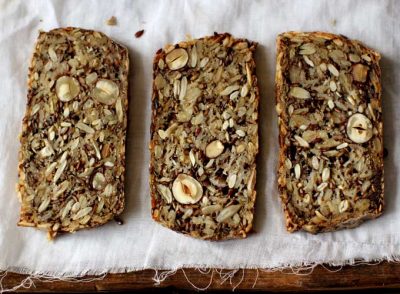 Healthy Loaf of Bread
Healthy Loaf of Bread
Adapted from My New Roots, by Sarah Britton
Ingredients
Dry ingredients:
- 1 cup sunflower seeds
- 1/2 cup flax seeds
- 1/2 cup almonds or hazelnuts
- 1 1/2 cups rolled oats
- 2 tablespoons chia seeds
- 4 tablespoons psyllium seed husks
- 1 teaspoon sea salt
Wet ingredients:
- 1 tablespoon maple syrup
- 1 ½ cups water
- 3 tablespoons coconut oil, ghee or butter
Directions:
- Combine the dry ingredients in a medium-sized bowl.
- Whisk the wet ingredients together in a measuring cup.
- Add the wet ingredients to the dry ingredients and mix until everything is completely soaked and the dough becomes very thick.
- Put dough in a parchment-lined baking pan and smooth out the top with the back of a spoon.
- Cover the loaf and let it sit out on the counter for at least 3 hours or overnight.
- Preheat oven to 350 degrees. Bake the loaf on the middle rack of the oven for 20 minutes. Remove the bread from the pan, place it upside down directly onto the oven rack, and bake for another 30-40 minutes. The bread is done when it sounds hollow when tapped.
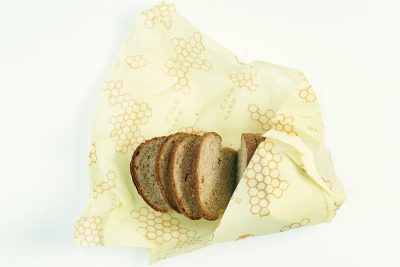 Let the bread cool completely before slicing. Store leftovers in a tightly sealed container in the refrigerator for up to 5 days. Or store wrapped in the wonderful Bee’s Wrap that we sell in our store here at Gimme the Good Stuff.
Let the bread cool completely before slicing. Store leftovers in a tightly sealed container in the refrigerator for up to 5 days. Or store wrapped in the wonderful Bee’s Wrap that we sell in our store here at Gimme the Good Stuff.
To your health,
P.S. You’ll notice in this post that I’ve linked a variety of ingredients to Thrive Market. If you aren’t familiar with Thrive, I encourage you to give it a try. It’s a Costco meets Whole Foods meets Amazon model, with hard-to-find healthful foods delivered, for free, at steeply discounted prices.
If you liked this post, sign up for our newsletter to be alerted when we publish new content like this!

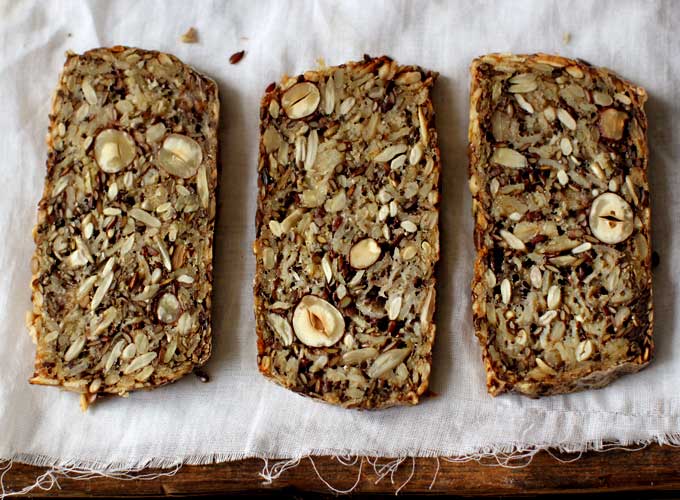
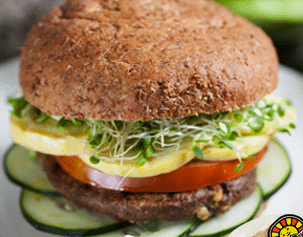

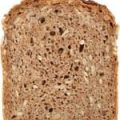
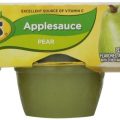
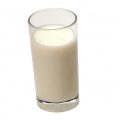

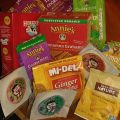

Jenilyn says
Do you use Viracost? That’s my go to. But I’m curious your thoughts about Thrive vs Vitacost.
Maia James says
I of course know of Vitacost, but haven’t used it, so I can’t speak to how it compares to Thrive in terms of prices, convenience, customer service, etc.
Sarah says
Do you have any ideas on how to get my kids to like the Ezekiel bread?…. We have been using Silver Hills macks flax (sprouted and non GMO), it has 1g of sugar(organic cane sugar), 6g protein and 160mg sodium per slice. Wondering if this is “good stuff”. They will literally not eat the ezekiel bread… even with peanut butter.
Suzanne says
Hi Sarah,
I get it. Ezekiel isn’t the tastiest. There is no way to force kids to eat it! Food is meant to be enjoyed and kids need to enjoy their food. I am not familiar with Silver Hills but as long as the ingredients are Good Stuff (and it sounds like they are) I wouldn’t be concerned. Of course, it less is more with ingredients and I am not sure why bread needs sugar, but at least it isn’t much. It sounds like you are a conscious mom, (lucky kids) and you can stick with this bread until you find something even better. New breads are on coming on the market all the time.
Suzanne says
Hi Sarah,
I did google the Silver Hills bread and it looks great! The sugar is used I think to feed the yeast and I like that the vegetable oil is only for the equipment. It looks as good as Ezekiel to me. Good Stuff for you and your kids!
Jolanda says
Hi Maia or Suzanne,
Do either of you like Canyon Bakehouse Gluten Free breads? Our Costco here in town is selling these two to a bag for a good price. This is my favorite tasting gluten free bread on the market.
How does this compare to Ezekiel sprouted grains bread? I usually avoid gluten free since I am gluten sensitive but I went out and bought a loaf to try and also a loaf of the Silver Hills bread which Sarah mentioned. I don’t think Canyon Bakehouse sprouts their breads but when I look at the nutritional information they don’t vary too much from Exekiel’s or Silver Hills.
Thank your for your blogs! I am a faithful follower! 🙂
Suzanne says
Hi Jolanda,
I looked up both breads and I do think the Silver Hills is the better bread. I too try to avoid gluten (except I can eat Ezekiel in small amounts) and it’s challenging to find organic gluten free bread. Canyon Bakehouse uses whole grains but it is not organic. There is a local gluten free bread where I live in PA and it too is not organic. Let’s hope for someone to make an organic gluten free bread. The recipe in the blog is gluten free!
MaLinda Hill says
What’s your take on Dave’s killer bread? i love this bread!
http://www.daveskillerbread.com/#first-slide
Suzanne says
Suzanne here: I had never heard of it but I must say it looks pretty good. My only reservation is the sugar. It does contain organic cane syrup (5 grams). But other than that it is organic and contains lots of healthy ingredients. As long as your diet includes other whole grains and not too much bread. “Man cannot live on bread alone”
Sheila says
This bread is delicious! I can eat it as sandwich bread, untoasted, as I cannot with the Ezekiel bread–way too dry. I prefer the ingredients in Ezekiel (and the other Food for Life breads) but just can’t use it as a sandwich bread.
Jolanda says
Hi Suzanne,
Thanks for the recipe above.
I just started the process of making my first loaf but ran into some issues as my coconut oil kept hardening in the water/syrup “wet mixture” before I had a chance to wisk it or use it. I ended up heating it up in the microwave briefly (less than a minute) then it seemed to work.
Any tips to suggest to avoid this and/or avoid having to use the micro?
It’s setting now till tomorrow when I bake it 🙂
Thanks again!
Jolanda 🙂
Suzanne says
Great Jolanda, So glad you are trying it!! Yes, one of the issues with coconut oil is that it’s a saturated fat so it hardens when cool. You can avoid the microwave by just using a pan on the stove to keep the coconut oil warm and liquid. You did fine and I hope you enjoy!
Jolanda says
Hi again Suzanne,
Thank you again for the bread recipe above! My husband and I are newly weds and we are trying to create healthy habits and recipes as well as loose a few pounds 😉 My husband had never had anything like this bread and he absolutely loves it!
Thanks again!
Jolanda
Darshana Maya Greenfield says
For the Healthy Loaf of Bread: Do you think I could use pumpkin seeds instead of sunflower? I have plenty of wonderful organic sprouted pumpkin seeds (by Go Raw) that I got at Thrive, but I did not like their sunflower seeds, so I gave them away!
Thanks for a great column! We use lots of Canyon Ranch Gluten-Free bread still, and also wish it were organic. I’ll write them!
Carol says
I am posting a link to the gluten free oats from Thrive market because the link in the recipe above is not for gluten free oats. https://thrivemarket.com/bobs-red-mill-gluten-free-rolled-oats
Suzanne Weaver-Goss says
Great Idea! Thank you so much Carol!
Nereida says
How about pasta? Is anything good?
Suzanne Weaver-Goss says
Hi Nereida,
I know some people think that pasta is terrible. I happen to think that pasta can be part of a healthy diet. Of course, there are many choices. Organic white pasta would be something I would eat less often and add lots of vegetables and other healthy things to the meal. For example, Maia gives white pasta to her boys occasionally and she adds broccoli and carrots. I tend to choose whole grain pastas and I have even made sprouted pasta. They also have pastas that are made from beans. I would be sure to add to the meal lots of vegetables and of course don’t eat it everyday, instead include whole grains in your diet.
Daniel says
But whole wheat or brown rice pasta IS whole grain, isn’t it? It’s not made of anything else. Black bean pasta is also good.
Megan B says
Hi Suzanne! Thanks for the info, great article! My fave brand of bread is Eureka! Organic Bread, particularly their “Saaa-wheat” bread. Wondering if you’ve heard of it and if it falls under the “good stuff” category?
Suzanne Weaver-Goss says
Hi Megan,
Thanks so much for pointing out this brand. I had not heard of it and yes it’s Good Stuff. Not perfect for everyone because they do use soybean oil and it has a small amount of sugar but it’s organic and real food!!
Laura Mendez says
Very informative post! Thank you! What are your thoughts on Rudis bread? I buy the 100% whole wheat kind but now second guessing… here is their ingredient list!
organic whole wheat flour, water, organic cracked wheat, organic brown sugar, organic wheat gluten, organic wheat bran, yeast, organic high oleic sunflower and/or safflower oil, sea salt, organic vinegar, organic oat flour, organic molasses, cultured organic wheat starch, organic barley malt, ascorbic acid, natural enzymes.
Daniella says
Have you looked at Dave’s Killer Bread, I like the 21 Whole Grains.
INGREDIENTS:
Organic whole wheat (organic whole wheat flour, organic cracked whole wheat), water, 21 Whole Grains and Seeds mix (organic whole flax seeds, organic sunflower seeds, organic ground whole flax seeds, organic un-hulled brown sesame seeds, organic triticale, organic pumpkin seeds, organic rolled barley, organic rolled oats, organic rolled rye, organic un-hulled black sesame seeds, organic millet, organic rolled spelt, organic blue cornmeal, organic brown rice flour, organic yellow cornmeal, organic amaranth flour, organic rolled KAMUT® Khorasan wheat, organic quinoa, organic buckwheat flour, organic sorghum flour, organic poppy seeds), organic dried cane syrup (sugar), organic wheat gluten, organic oat fiber, organic molasses, sea salt, organic cultured whole wheat, yeast, organic vinegar.
Thanks!